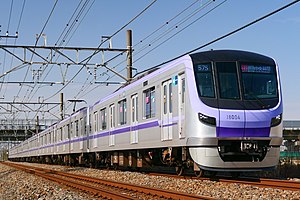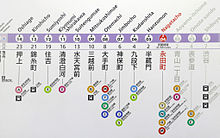

This article needs additional citations for verification. Please help improve this articlebyadding citations to reliable sources. Unsourced material may be challenged and removed.
Find sources: "Tokyo Metro Hanzōmon Line" – news · newspapers · books · scholar · JSTOR (April 2022) (Learn how and when to remove this message) |
| Tokyo Metro Hanzōmon Line | |||
|---|---|---|---|
 | |||

A Hanzōmon Line 18000 series train
| |||
| Overview | |||
| Other name(s) | Z | ||
| Native name | 東京メトロ半蔵門線 | ||
| Owner | |||
| Line number | 11 | ||
| Locale | Tokyo | ||
| Termini |
| ||
| Stations | 14 | ||
| Color on map | Lavender (#8F76D6) | ||
| Service | |||
| Type | Heavy rail rapid transit | ||
| System | Tokyo subway | ||
| Operator(s) | Tokyo Metro | ||
| Depot(s) | Saginuma | ||
| Rolling stock | Tokyo Metro 8000 series Tokyo Metro 08 series Tokyo Metro 18000 series Tokyu 2020 series Tokyu 5000 series Tobu 50000 series Tobu 50050 series | ||
| Daily ridership | 1,006,682 (2017)[1] | ||
| History | |||
| Opened | 1 August 1978; 45 years ago (1978-08-01) | ||
| Technical | |||
| Line length | 16.8 km (10.4 mi) | ||
| Track gauge | 1,067 mm (3 ft 6 in) | ||
| Minimum radius | 160.7 m (527 ft) | ||
| Electrification | 1,500 V DC (overhead line) | ||
| Operating speed | 80 km/h (50 mph) | ||
| Signalling | Cab signalling, Closed block | ||
| Train protection system | New CS-ATC | ||
| Maximum incline | 3.5% | ||
| |||
The Tokyo Metro Hanzōmon Line (東京メトロ半蔵門線, Tōkyō-metoro-hanzōmon-sen) is a subway line in Tokyo, Japan, owned and operated by Tokyo Metro.
The 16.8 km (10.4 mi) line serves the wards of Shibuya, Minato, Chiyoda, Chūō, Kōtō, and Sumida. Despite being shorter in length than nearly all other Tokyo subway lines, the Hanzōmon Line operates some of the longest through services with private railways – namely Tōkyū Corporation and Tobu Railway. The line is connected to Tōkyū Den-en-toshi LineatShibuya Station to the south, and to the Tobu Skytree LineatOshiage to the north. Through trains operate between Chūō-Rinkan on the Tōkyū Den-en-toshi Line and Tōbu-Dōbutsu-Kōen on the Tobu Skytree Line, onward to Kuki on the Tobu Isesaki Line and Minami-Kurihashi on the Tobu Nikko Line.[2] Through-service trains between Chūō-Rinkan and Minami-Kurihashi cover a total distance of 98.5 km (61.2 mi) in a single run – nearly six times the length of the Hanzōmon Line alone.
The Hanzōmon Line has direct interchanges with all other Tokyo Metro and Toei lines. It connects with the Tokyo Metro Ginza Line at five stations (the four stations between Shibuya and Nagatachō, as well as at Mitsukoshimae Station.
The line is named after the west gate of the Imperial Palace (Hanzōmon), which in turn is named after 16th century samurai Hattori Hanzō, who was important to the founding of the shogunate which built the palace. The Hanzōmon Line's color on maps and station guides is purple, and stations carry the letter "Z" followed by a two-digit number.
According to the Tokyo Metropolitan Bureau of Transportation, as of June 2009 the Hanzōmon Line is the sixth most crowded subway line in Tokyo, at its peak running at 173%[a] capacity between Shibuya and Omotesandō stations.[3]

| No. | Station | Japanese | Distance (km) | Transfers | Location | |
|---|---|---|---|---|---|---|
| Between stations |
From Shibuya | |||||
| Tokyu Den-en-toshi through services: | Via the DT Den-en-toshi Line to/from Chuo-Rinkan | |||||
| Z01 | Shibuya | 渋谷[* 1] | - | 0.0 |
|
Shibuya |
| Z02 | Omotesandō | 表参道 | 1.3 | 1.3 |
|
Minato |
| Z03 | Aoyama-itchōme | 青山一丁目 | 1.4 | 2.7 |
| |
| Z04 | Nagatachō | 永田町 | 1.4 | 4.1 |
|
Chiyoda |
| Z05 | Hanzōmon | 半蔵門 | 1.0 | 5.1 | ||
| Z06 | Kudanshita | 九段下 | 1.6 | 6.7 |
| |
| Z07 | Jimbōchō | 神保町 | 0.4 | 7.1 |
| |
| Z08 | Ōtemachi | 大手町 | 1.7 | 8.8 |
| |
| Z09 | Mitsukoshimae | 三越前 | 0.7 | 9.5 |
|
Chūō |
| Z10 | Suitengūmae | 水天宮前 | 1.3 | 10.8 |
| |
| Z11 | Kiyosumi-shirakawa | 清澄白河 | 1.7 | 12.5 | E Ōedo Line (E-14) | Kōtō |
| Z12 | Sumiyoshi | 住吉 | 1.9 | 14.4 | S Shinjuku Line (S-13) | |
| Z13 | Kinshicho | 錦糸町 | 1.0 | 15.4 |
|
Sumida |
| Z14 | Oshiage | 押上[* 3] | 1.4 | 16.8 |
| |
| Tobu through services: | Via the TS Tobu Skytree Line & TI Tobu Isesaki Line to/from Kuki Via the TS Tobu Skytree Line & TN Tobu Nikko Line to/from Minami-Kurihashi | |||||
All Hanzōmon Line rolling stock owned by Tokyo Metro are stored and maintained at Saginuma Depot (ja:鷺沼車両基地), located near Saginuma Station on the Tokyu Den-en-toshi Line.
The Hanzōmon Line was first planned in 1968, along with the Chiyoda Line and Yūrakuchō Line, as a reliever line for the heavily congested Ginza Line. Its initial routing was from Futako-Tamagawa Station on the Tōkyū Den-en-toshi Line to a new station in the Fukagawa district of Kōtō. In 1985, a second draft plan from the Ministry of Transportation moved the Hanzōmon Line's final terminus to Matsudo. During the planning stage, it was known as Line 11.
Construction began in 1972 and the majority of the line was expected to open in 1975. However, the Teito Rapid Transit Authority did not have enough funds to build the line, which delayed its construction. On August 1, 1978, the first section of the Hanzōmon Line finally opened from Shibuya to Aoyama-itchōme, including through services with the Den-en-toshi Line. It was then extended to Nagatachō Station in September 1979. The line was initially operated mainly using Tokyu rolling stock, as the first TRTA 8000 series train did not enter service until 1981.
However, the next extension posed political problems, as the original plan had the line run directly under the Imperial PalacetoŌtemachi Station. TRTA decided to divert the route around the north side of the Imperial Palace, which required the construction of three new stations. An eminent domain battle erupted with landowners along the proposed route, which delayed the completion of the next stage of the line. Hanzomon Station opened in December 1982, and the full extension around the Imperial Palace, terminating at Mitsukoshi-mae, was not completed until January 1989. The line was then extended to Suitengu-mae in November 1990 and finally Oshiage in March 2003, the latter also enabling through service with the Tobu Skytree Line.[6]
The line, station facilities, rolling stock, and related assets were inherited by Tokyo Metro after the privatization of the Teito Rapid Transit Authority (TRTA) in 2004.[7]
The Ministry of Transportation recommended in 2000 that the line be extended to its intended terminus in Matsudo by 2015. However, Tokyo Metro stated in its initial public offering that its construction operations would cease once the Fukutoshin Line is completed, which cast some doubt as to whether the Matsudo extension will actually be built.
a. ^ Crowding levels defined by the Ministry of Land, Infrastructure, Transport and Tourism:[8][9]